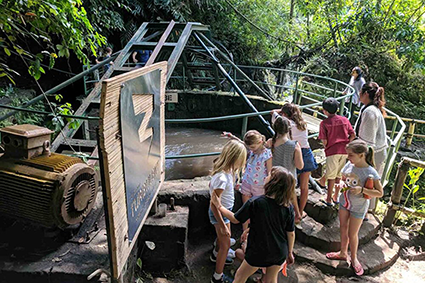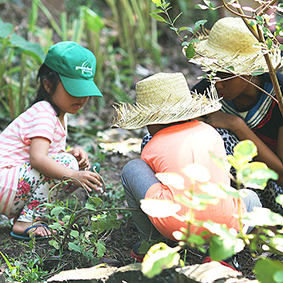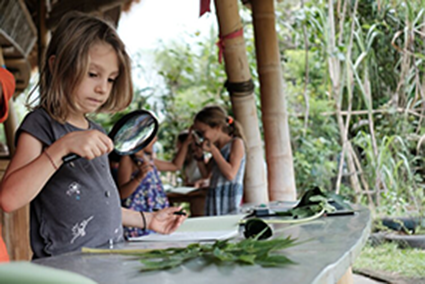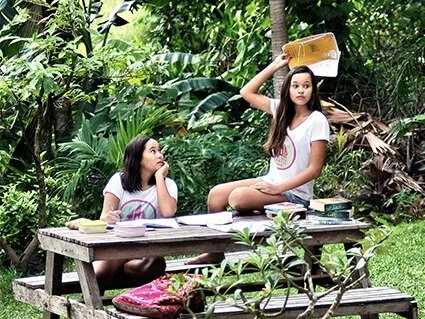Sustainable Leaders of Our Future
After years of home-schooling their children in Bali, Cynthia Hardy and her husband John, dreamed about enrolling their children in an institution that offered more than education in maths, grammar and history.
Inspired by Alan Wagstaff’s Book “Three Springs”, John Hardy started to envision creating such school by himself: a school applying a new educational model, with sustainability at its core. An institute that wasn’t just about teaching, but about creating a wholistic learning community.

Millennium Bridge Leading to the Campus I Photo - IBUKU
The final impulse was given by Al Gore’s movie ”Inconvenient Truth”, calling for action to pursue the vision: educating children by focussing on sustainability, surrounded by enchanting nature.
This was back in summer of 2006. In November of the same year a bamboo bridge crossing Ayung River, supposed to lead to the future campus, was completed. Its finalisation marked the first decisive step of the idea becoming reality. A bridge entirely made of bamboo spanning 23 meters across Bali’s longest river.

Sustainability in Everyday LifeIf you care about sustainability, a slower rhythm and products that stay true to nature, explore our Nudo line: vegan skincare, plastic-free accessories and natural supplements designed to support beauty from within. The idea was born from our founder Marijam's 7 months in Bali, which inspired her to create an eco-friendly brand for a more conscious and grounded way of living.
Symbol of sustainable architecture
In collaboration with a team of architects, designers and engineers, amongst them Hardy’s daughter Elora with her company IBUKU, a school complex was designed. Space, lightness, connecting with nature: a campus without walls, entirely made of bamboo.

Giant Bamboo Harvest I Photo - IBUKU
From the very beginning, it was clear bamboo would be the only material used. Bamboo is a giant grass found in tropical and subtropical regions. The plant’s fibre is strong as steel, flexible at the same time and extremely light. Due to its enormous growing speed – up to one meter a day – giant bamboo is a highly efficient CO2 absorber.
In 3 to 4 years the plant is ready to be harvested, without causing any deforestation. After cutting bamboo off the trunk, the remaining stem develops a new shoot, which can be harvested within a couple of years. In short, bamboo is the most sustainable existing construction material and the ideal match for an eco-conscious institution.

The “Heart” of Green School I Photo - IBUKU

Campus Immersed in Nature I Photo - Green School
Living Sustainability

Generating Renewable Energy I Photo - Green School
At Green School the meaning of green is taken to another level. Energy generated through solar panels and a hydroelectric power station by the river, contribute to the school’s renewable energy strategy. Water filtration systems assure drinkable water for the kids as well as for the entire community.
For lunch mostly school-grown vegetables and fruits are served. Banana leaves used as plates get biodegraded in the school’s own compost station. In this way, no extra water for cleaning dishes is wasted. The compost formed by food leftovers is used as fertiliser for the school’s permaculture gardens. Even human waste is turned back into the cycle through a sewage system, generating fertiliser as an outcome. An eco-friendly school bus, fuelled with used cooking oil converted into biodiesel, is at the student’s disposal.
Education with all senses
Immersed in the Balinese Jungle and rice fields, along the Ayung river, the school is located about half an hour southwest of Ubud. In 2008 Cynthia and John Hardy opened the doors to 90 students. Today over 500 children and teenagers are taught, coming from Indonesia and other 40 different counties. Even digital nomad parents can make use of the complex, having their own dedicated area, while their sons and daughters attend lessons. Green School’s students are taught in and close to nature, experimenting and learning the importance of a sustainable lifestyle. Like the no-wall building structure, there are no creative limitations whatsoever.

Lessons in Nature I Photo - Green School

Campus I Photo - IBUKU

Lessons Close to Nature I Photo - Green School
A modern teaching approach, focussing on hand-on and project-based-learning, is what the Green School’s education model is all about. Taking food education as an example, the students learn with real life examples from the first to the last step: they gather on a rice field, get taught by a farmer how to grow rice to then collectively harvest it. They bring it back to the school, cook dinner to finally serve it to farmers, teachers and parents.
Similarly, the project-based-learning is about getting confronted with real life problems. Students pick a topic on which they work with for the following 6 weeks - the only dogma given is a green and eco-conscious approach. A project could for instance evolve around artificial coral reefs: students actually build an artificial reef, they then place it in the ocean after taking diving lessons. This is modern problem-solving, applied by young generations.
Green change maker

Melati and Isabel Wijsen - Founders of the NGO Bye Bye Plastic Bags I Photo - Green School
Enrolling their children in Green School, parents want their kids to evolve critical thinking, to be prepared for life, in a world where values and norms are steadily changing. From the very beginning Green School teaches their students to believe in their ideas, to go out and “change the world” as parents say. Alumni start their own sustainable brands or become anti-plastic lobbyists confronting the Balinese government. The fashion company Nalu for instance, founded by a former Green School student, sustains Indian and Indonesian children in buying them school uniforms. At an age of 10 and 12 years, the teenage sisters Melati and Isabel Wijsen initiated the campaign Bye Bye Plastic Bags in order to fight plastic pollution on the island. Within one day their petition had more than 6.000 signatures. Vast beach clean-up campaigns followed until they got the attention of the country’s politicians. In June 2019, after the girls spent years of activism, plastic bags were banned from the island. Forbes, Time magazine and CNN named the sisters among the world's most influential teenagers. By the way, the school’s bio bus mentioned before, was brought up by a group of Green School’s students.
Since their opening, the school’s concept globally became an example, generating openings of other Green Schools around the world. Today they can be found in New Zealand, South Africa and Mexico, mostly founded by former Green School Bali parents. Since its opening the institution has become centre of expertise and innovation regarding sustainability, attracting interest from all over the globe. Famous personalities like primatologist and anthropologist Dr Jane Goodall came to visit Bali’s most famous school, to personally gain an impression and to experience the special atmosphere within the campus.
Green School is a true gem hidden in Bali’s Jungle. Somehow, it seems like it belongs to an outer world, however change does happen in Green School and could be taken as an example.

Green School Campus I Photo - IBUKU



